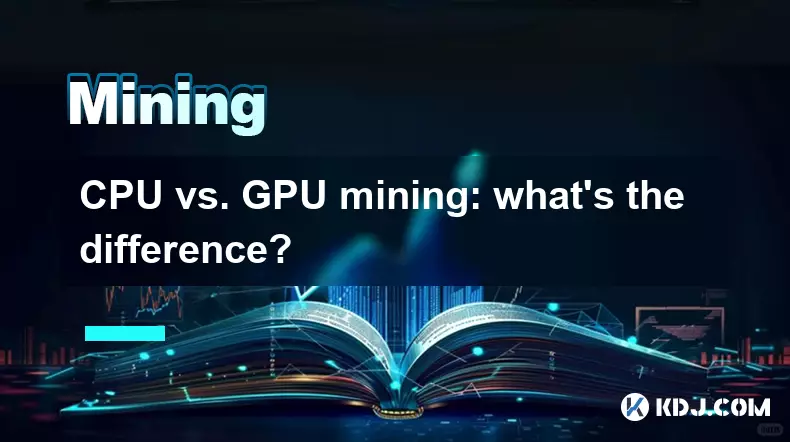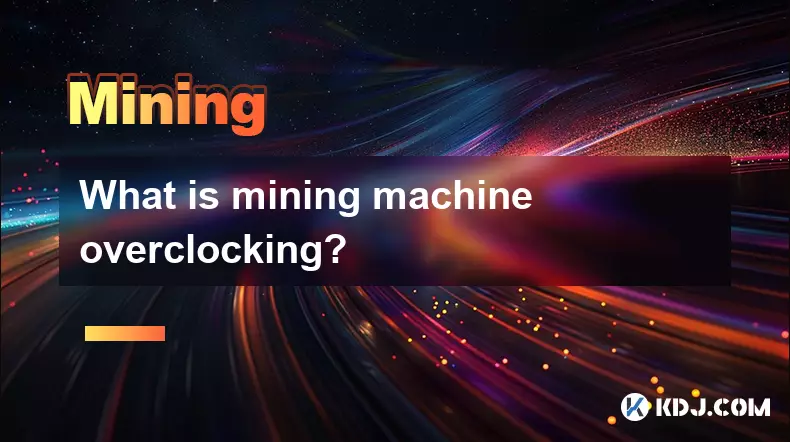-
 bitcoin
bitcoin $114779.865156 USD
2.30% -
 ethereum
ethereum $4226.519789 USD
2.39% -
 tether
tether $1.000545 USD
0.04% -
 xrp
xrp $2.890223 USD
0.92% -
 bnb
bnb $1030.029301 USD
2.95% -
 solana
solana $212.824944 USD
1.69% -
 usd-coin
usd-coin $0.999757 USD
0.01% -
 dogecoin
dogecoin $0.234961 USD
-0.27% -
 tron
tron $0.337174 USD
0.42% -
 cardano
cardano $0.804783 USD
0.09% -
 hyperliquid
hyperliquid $45.748770 USD
-2.85% -
 chainlink
chainlink $21.699170 USD
0.82% -
 ethena-usde
ethena-usde $1.001452 USD
0.08% -
 avalanche
avalanche $30.237800 USD
1.14% -
 stellar
stellar $0.372604 USD
1.52%
CPU vs. GPU mining: what's the difference?
In the early days of Bitcoin, CPU mining was feasible, but as network difficulty grew, GPUs took over due to superior parallel processing and efficiency.
Sep 13, 2025 at 03:18 am

CPU Mining: The Early Days of Cryptocurrency
1. In the early stages of cryptocurrency, particularly around the launch of Bitcoin in 2009, mining was designed to be accessible to anyone with a standard computer. CPUs (Central Processing Units) were the primary tools used to solve cryptographic puzzles and validate transactions on the blockchain.
2. CPU mining relies on the general-purpose processing power of a computer’s main processor. It was effective at the time because the network difficulty was low, and the number of participants was limited. This allowed individuals to mine Bitcoin profitably from their personal computers.
3. As the network grew, the computational demands increased. CPUs, while versatile, are not optimized for the repetitive mathematical calculations required in mining. Their architecture handles a wide range of tasks but lacks the parallel processing capabilities needed for high-efficiency mining.
4. Over time, CPU mining became obsolete for major cryptocurrencies like Bitcoin. The rise of more powerful hardware quickly outpaced what CPUs could offer. Today, CPU mining is only viable for certain privacy-focused or ASIC-resistant coins such as Monero (XMR), where developers intentionally design algorithms to remain accessible to everyday users.
GPU Mining: A Leap in Performance
1. GPUs (Graphics Processing Units), originally built for rendering graphics in gaming and video production, turned out to be exceptionally well-suited for cryptocurrency mining. Unlike CPUs, GPUs contain thousands of smaller cores designed to handle multiple tasks simultaneously, making them ideal for the parallel computations involved in mining.
2. The shift to GPU mining began around 2010-2011 and marked a significant increase in mining efficiency. Miners could now process far more hashes per second, giving them a competitive edge. This led to the formation of mining rigs—custom-built systems housing multiple high-end GPUs running in tandem.
3. Ethereum played a major role in popularizing GPU mining due to its Ethash algorithm, which was designed to be memory-hard and resistant to ASICs. This allowed GPU miners to dominate the network for years, contributing to a more decentralized mining ecosystem.
4. The demand for GPUs skyrocketed, causing global shortages and price surges, especially during periods of high crypto market activity. Gamers and professionals in creative fields often found themselves priced out of the market as miners bought up available stock.
5. GPU mining remains relevant today for several altcoins and in regions where electricity costs are low, allowing miners to maintain profitability despite increasing difficulty and hardware expenses.
Key Differences in Architecture and Efficiency
1. The fundamental difference between CPU and GPU mining lies in their processing architecture. CPUs are optimized for sequential serial processing, handling a few complex threads at high speed. GPUs excel at parallel processing, managing thousands of simpler threads at once—perfect for mining algorithms that require repetitive hashing.
2. In terms of hash rate, a typical high-end GPU can deliver tens to hundreds of megahashes per second (MH/s), while a CPU usually manages only a few MH/s. This performance gap makes GPUs far more efficient for most mining operations.
3. Power consumption is another critical factor. GPUs generally offer a better performance-per-watt ratio than CPUs when mining. However, mining rigs with multiple GPUs can consume significant amounts of electricity, requiring careful thermal management and stable power supplies.
4. Mining profitability calculations must account for electricity costs, hardware depreciation, and cooling requirements—factors that disproportionately affect CPU mining due to its lower output.
Mining Algorithms and Coin Compatibility
1. Not all cryptocurrencies are mined using the same methods. Bitcoin uses SHA-256, an algorithm now dominated by ASICs, rendering both CPU and GPU mining impractical. However, other coins use algorithms specifically designed to resist ASIC dominance.
2. Coins like Monero (CryptoNight), Ravencoin (KawPow), and Ethereum Classic (Ethash) are examples where GPU mining remains competitive. Some of these networks have implemented changes to maintain ASIC resistance, preserving a level playing field for GPU miners.
3. CPU mining still has a niche in privacy coins and decentralized networks that prioritize accessibility. For instance, Monero’s RandomX algorithm favors CPUs, ensuring that mining power isn’t concentrated in the hands of those with expensive GPU farms or ASICs.
4. The choice between CPU and GPU mining ultimately depends on the target cryptocurrency, local electricity costs, initial hardware investment, and long-term maintenance. Miners must research the specific requirements and profitability metrics of each coin before committing resources.
Frequently Asked Questions
Can I mine Bitcoin with a CPU today?No, mining Bitcoin with a CPU is no longer feasible. The network difficulty and competition from ASIC miners make CPU mining unprofitable, even with low electricity costs.
Is GPU mining still profitable in 2024?Yes, GPU mining can still be profitable depending on the cryptocurrency, electricity rates, and hardware efficiency. Coins like Ethereum Classic, Ravencoin, and Flux are among those where GPU mining remains viable.
Why are some coins designed to be ASIC-resistant?ASIC-resistant coins aim to promote decentralization by preventing mining centralization in the hands of a few large players who can afford expensive ASIC hardware. This allows individual miners using CPUs or GPUs to participate fairly.
Do I need special software for CPU or GPU mining?Yes, different mining software is optimized for CPU or GPU use. Examples include XMRig for CPU mining Monero and T-Rex or GMiner for GPU mining Ethereum Classic or Ravencoin. The software must match the algorithm and hardware for optimal performance.
Disclaimer:info@kdj.com
The information provided is not trading advice. kdj.com does not assume any responsibility for any investments made based on the information provided in this article. Cryptocurrencies are highly volatile and it is highly recommended that you invest with caution after thorough research!
If you believe that the content used on this website infringes your copyright, please contact us immediately (info@kdj.com) and we will delete it promptly.
- AI Training's Energy Crisis: Can Decentralization with Greg Osuri Offer a Solution?
- 2025-09-30 20:45:14
- Prenetics, Danny Yeung, and Token 2049: A Bold Bitcoin Strategy
- 2025-09-30 20:45:14
- ChatGPT, Bitcoin, and $HYPER: Riding the Crypto Wave
- 2025-09-30 16:25:14
- Mutuum Finance (MUTM): Riding the DeFi Wave with Crypto Price Prediction
- 2025-09-30 16:25:14
- XRP ETF Approval Odds Soar: Analyst Predicts $33 Price Surge!
- 2025-09-30 16:30:01
- Keel, Solana, and Sky Stablecoin: Fueling the Future of DeFi
- 2025-09-30 16:45:13
Related knowledge

The difference between staking and mining
Sep 24,2025 at 05:18am
Understanding Staking in the Cryptocurrency Ecosystem1. Staking involves holding funds in a cryptocurrency wallet to support the operations of a block...

How to participate in testnet mining?
Sep 22,2025 at 09:18am
Understanding Testnet Mining in the Crypto Ecosystem1. Testnet mining is a method used by blockchain developers to simulate real-world conditions on a...

How to dispose of abandoned mining machines?
Sep 19,2025 at 08:19pm
Assessing the Condition of Abandoned Mining Rigs1. Begin by inspecting each mining machine for visible damage, corrosion, or missing components. Machi...

How to identify high-quality mining pools?
Sep 21,2025 at 03:19pm
Reputation and Track Record1. A mining pool’s reputation is built over time through consistent performance and transparency. Pools that have operated ...

Advantages of decentralized mining pools
Sep 20,2025 at 04:36pm
Enhanced Security and Resistance to Censorship1. Decentralized mining pools operate on blockchain-based smart contracts, eliminating the need for a ce...

What is mining machine overclocking?
Sep 21,2025 at 07:19pm
Understanding Mining Machine Overclocking1. Mining machine overclocking refers to the process of increasing the operating frequency of a cryptocurrenc...

The difference between staking and mining
Sep 24,2025 at 05:18am
Understanding Staking in the Cryptocurrency Ecosystem1. Staking involves holding funds in a cryptocurrency wallet to support the operations of a block...

How to participate in testnet mining?
Sep 22,2025 at 09:18am
Understanding Testnet Mining in the Crypto Ecosystem1. Testnet mining is a method used by blockchain developers to simulate real-world conditions on a...

How to dispose of abandoned mining machines?
Sep 19,2025 at 08:19pm
Assessing the Condition of Abandoned Mining Rigs1. Begin by inspecting each mining machine for visible damage, corrosion, or missing components. Machi...

How to identify high-quality mining pools?
Sep 21,2025 at 03:19pm
Reputation and Track Record1. A mining pool’s reputation is built over time through consistent performance and transparency. Pools that have operated ...

Advantages of decentralized mining pools
Sep 20,2025 at 04:36pm
Enhanced Security and Resistance to Censorship1. Decentralized mining pools operate on blockchain-based smart contracts, eliminating the need for a ce...

What is mining machine overclocking?
Sep 21,2025 at 07:19pm
Understanding Mining Machine Overclocking1. Mining machine overclocking refers to the process of increasing the operating frequency of a cryptocurrenc...
See all articles










































































